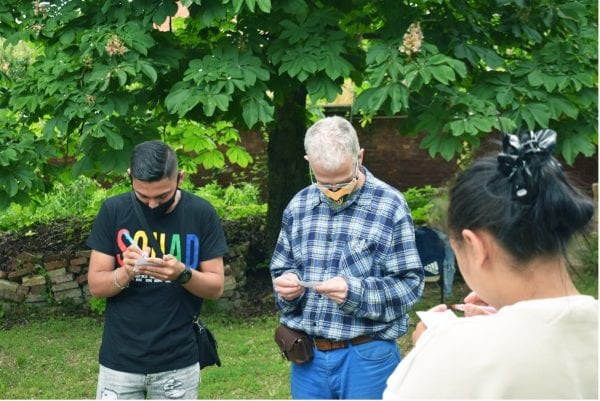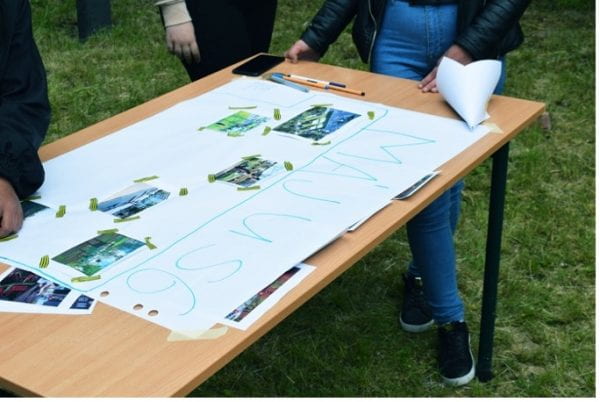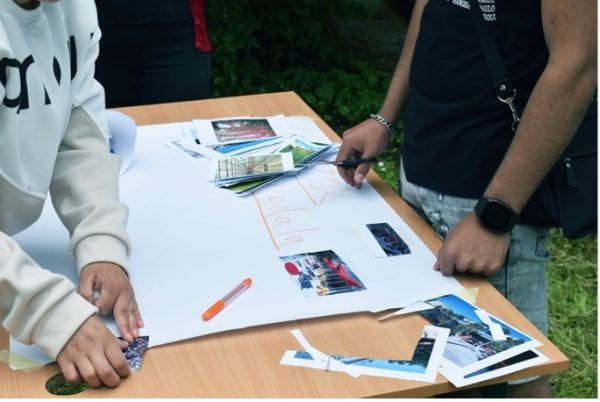Introducing our Project Partners
Our organizational partners at the LADDER (Laboratory with Kids for Democratic School Environments) Living Lab held two workshops with the students, faculty, and staff of the Dr. Ámbédkar School in Miskolc, Hungary. At these workshops, the LADDER Living Lab team facilitated community conversations to help identify the school’s most pressing concerns and to generate ideas of how to address them. In this and the following two blog posts, we’ll introduce the LADDER Living Lab and the organizational partners that carried out these workshops. These workshops provided the basis for the plans we are implementing in the project’s current construction phase, funded by the Davis Projects for Peace grant.
We would like to thank the LADDER Living Lab team and the Dr. Ámbédkar School community for their ongoing work in generating a common vision for the development of the school grounds!
An Introduction to the LADDER Living Lab and LED2LEAP
The LADDER Living Lab supports school communities to collaboratively shape the outdoors. Participation is key to creating more efficient and safer environments. It also provides students experience in practicing democracy and teaches youth how they can discover, observe, understand, and actively shape the environment and landscape they live in.
The LADDER Living Lab is led by the Institute of Landscape Architecture, Urban Planning & Garden Art of the Hungarian University of Agriculture and Life Sciences. Its work is carried out in partnership with the KultúrAktív Association, bringing a specialization in built environment education. This collaboration was formed under the umbrella of the LED2LEAP (Landscape Education for Democracy towards Learning, Education, Agency and Partnership) Erasmus+ project, an international initiative that identifies opportunities for and promotes landscape democracy. Six months ago, the Dr. Ámbédkar School in Miskolc, Hungary joined the LADDER team. Since then, the team has participated in many organizational meetings. However, due to COVID-19, these were conducted mostly online or remotely. In the spring semester of the 2020/2021 academic year, university students in landscape architecture began analyzing and mapping the school community and the environment in which they currently operate. These university students prepared interviews and remote site visits to understand local challenges and opportunities related to the local environment. In the end of May, the LADDER team finally had the opportunity to visit the school community in person. We held two workshops with the school community – including students, teachers, and staff – to set a common vision and goals for the development of the schoolyard and dormitory garden.
Identifying a Common Challenge: Workshop #1 at the Dr. Ámbédkar School

During this first workshop at the Dr. Ámbédkar School, we focused on identifying a common challenge. Before setting a common vision and specific goals, it is important to agree on a common challenge that the community feels related to. Therefore, we prepared in advance – in consultation with the leaders at the school – six different scenarios that reflect the school’s challenges. While these scenarios differ, they overlap in many ways.
1. An Open Schoolyard:
What happens if we open the gates of the schoolyard? Can a schoolyard both welcome students and engage the local community (friends, family, etc.)? Can it act as a social hub?
2. An Outdoor Schoolyard:
Learning outside can be fun. But how can we provide an environment that is comfortable and conducive to outdoor teaching? What can we learn from or in nature? How can we create places for learning in groups and alone?
3. An Active Schoolyard:
What kind of active functions can we have in the schoolyard? How can we engage everyone from the school community and offer outdoor activities for all? How can we keep the schoolyard active all year long?
4. The Schoolyard as a Home:
How can we create a safer, more comfortable environment that is not only cozy, but feels like home? How can small things (colors, flowers, benches, artwork, etc.) make a big impact on the schoolyard’s atmosphere?
5. Life after School:
What is the best use for the schoolyard during breaks? How can we use the schoolyard during afternoons and weekends? What happens during the summer break?
6. Redesigning the Schoolyard:
How can we use already-existing structures that are not originally designed for educational use? For example, what could we do with the garages? How can we turn the disadvantages of the space into advantages?
In an opening exercise, we asked participants to choose the scenario they felt most connected to. We designated six spots, each of which corresponded to one of the scenarios. Participants then had to go to the spot they choose. After a first round of selection, we had a short discussion and erased the three spots with the fewest votes. Participants gathered again and we held a second round. While in the first round, participants visited a wider range of scenarios (only ‘Life after School’ received 0 votes), during the second round a wide majority of the participants – 13 out of 20 – selected ‘An Active Schoolyard.’ The other seven participants selected ‘Redesigning the Schoolyard’ (five) and ‘The Schoolyard as a Home’ (two). The aim of this task was to find out what aspects, questions, and challenges of the school’s environment are important to the students and teachers.

After selecting a common challenge, we asked the participants to set goals collaboratively to address this challenge. To this end, we used a method called the ‘Nominal Group Technique’ that is designed to facilitate democratic decision-making processes. First, we asked participants to write two goals individually that they thought important.
After that, we had a sharing round, where everybody had to explain these two goals to the group and then add them to our common idea wall. At this time, only clarification questions were allowed by the others. Once we had all the individual goals up on the wall, we started to create clusters of similar goals.

After organizing the goals, we asked the participants to vote for their favorites. Everyone had five votes and there was no restriction on how they could use these votes. Participants could use their five votes for one goal, for five different goals, etc., and marked their choices using stickers. After this voting session, we reviewed the results and identified four themes that received the most votes:
Theme 1: Food Goals (a vending machine, planting fruit trees and a vegetable garden, creating an outdoor dining area, caring for livestock)
Theme 2: Outdoor Exercise and Play Goals (outdoor gym, darts, foosball, ping-pong)
Theme 3: Group Sports Goals (football, basketball, badminton)
Theme 4: A Sculpture of Me
In addition to the themes mentioned above, other goals included more school programming, an outdoor library, a designated smoking area, outdoor classrooms, solar-powered lighting, and a swing.
Theme 4 (A Sculpture of Me) began as a joke of one student, who suggested the goal of putting up a sculpture of himself in the schoolyard. With his friends, they together put up many votes for this goal; consequently, we had to take this goal into consideration as we did not want to intervene and take it down. After the voting session, we formed four groups from the participants. Each group worked on the four themes in parallel and developed a more concrete vision for what these goals could mean and what actions could help fulfill them. They worked on big boards and could select from previews that we printed for them in advance.


As the students who voted for Theme 4 (A Sculpture of Me) declined to work further on this topic, the other participants who got this topic were less than enthusiastic about the idea. They changed the theme to ‘more school programs,’ which turned out to be a very good topic, based on the feedback we received later.